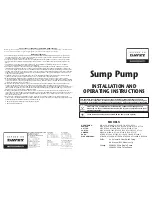
Priming the pump is required to purge air from the hose. Don’t operate
the pump without it being primed.
1. Ensure the pump is switched
off at the mains power.
2. Remove the priming plug from
the top of the pump housing by
turning anti clockwise.
3. Fill the pump completely with
water. Ensure the pump and
inlet pipe or hose are full.
Replace the priming plug.
4. Fully open any (shut-off
mechanisms, spray nozzles, valves,
etc. in the pressure line) so that the air
can escape without obstruction.
5. Switch the device on at the mains
plug.
Note:
When the pump is fully primed and
air is flushed out of the suction cycle, the pump is ready to operate. The
pump may take several minutes to fully prime air from the suction line
and inside the pump.
6. When water runs out evenly, close any shut-off mechanisms, spray
nozzles etc. in the pressure line. The pump will now pressurize and
be ready for use.
Note:
IPX4 - pump can handle splashing of water with no harmful effect.
5. STARTING
4. PRIMING THE PUMP
OPERATION
WARNING!:
THIS PRODUCT IS INTENDED FOR
PUMPING WATER IN A HOME DOMESTIC APPLICATION.
DO NOT USE IT FOR CORROSIVE, ABRASIVE, EXPLOSIVE
OR DANGEROUS LIQUIDS.
CAUTION.
THE PUMP SHOULD BE FILLED WITH WATER
AFTER EACH NEW CONNECTION OR IF WATER LOSS OR
AIR INTAKE HAS OCCURRED. EXTENDED OPERATION
WITHOUT A WATER REFILL WILL DAMAGE THE PUMP!
CAUTION.
THE PUMP MUST NOT BE ALLOWED TO RUN DRY.
SUFFICIENT WATER MUST BE ON HAND AT ALL TIMES.
WARNING!:
THIS PUMP MUST BE USED WITH
A RESIDUAL CURRENT DEVICE WITH RATED
RESIDUAL CURRENT OF 30mA OR LESS.
Note:
When the pump is fully primed and the air has been flushed
out, the pump is ready to operate.
Starting the pump
The pump and suction line must
be connected and filled with water,
refer
“PRIMING THE PUMP”
.
1. Turn the pump on at the mains
power.
2. Fully open any shut-off
mechanisms (spray nozzles,
valves, etc.) in the pressure line so that the air can escape
without obstruction.
3. Check to make sure that water is coming out.
Note:
If the pressure line is closed, (such as shutting off a tap
down stream) the pump will build up pressure, then switch off at the
preset cut off when the pressure line is opened again, the pump will
automatically restart.
If the motor does not start up or the pump does not build up any
pressure or if similar faults occur, turn the device off and refer to
“
TROUBLESHOOTING”
section to find a remedy .


























